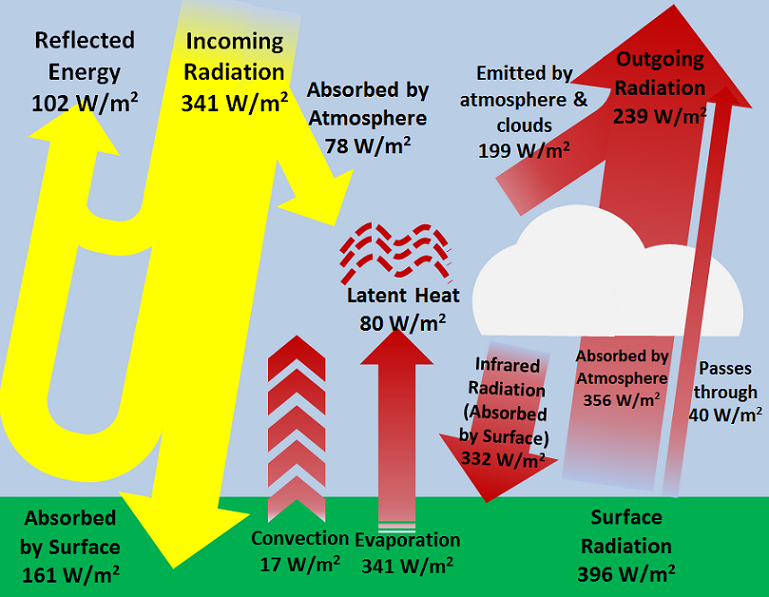The Earth is Continuously Receiving Heat From the Atmosphere as Well as From the Sun
Earth's heat balance
Earth's heat balance is and extremely important factor in what makes the Earth livable. The fact that the Earth can respond to slight changes in the amount of incoming radiation to maintain a fairly stable temperature is a result of Earth's energy budget. This phenomenon is also closely connected to flows on the Earth, and the Solar energy to the Earth. Essentially all of the energy the Earth receives is in radiant energy that originates from the Sun. The temperature of the Earth is a balancing act, with greenhouse gases in the atmosphere contributing to a planet that is inhabitable. This balance of temperature is maintained through several different mechanisms.
Origin of the Energy
The Earth receives a large amount of energy from the Sun, over 1.7 x 1017 joules every second (or 1.7 x 1017 Watts), and it is this energy that results in a warm, livable planet.[1] However, only a certain amount of this energy is absorbed by the atmosphere and used to heat the Earth. About 70% is absorbed by the planet, and the remaining 30% is reflected back to space by various surfaces such as clouds, ice, and deserts.[2] This is the source of energy for Earth's climate and biosphere. An in-depth look at where all this incident energy goes can be seen in Figure 1 below.

Figure 1. Detailed diagram showing incoming and outgoing energy in a balanced example of Earth's energy budget, with incoming and outgoing values of 341 W/m2. General flows of energy on the surface and in the atmosphere are shown as well.[3]
Balancing Act
If all that contributed to the temperature of the Earth was the incoming, absorbed sunlight then the temperature of the Earth would rise nearly 1 million degrees Celsius over a billion years.[4] Thus, it is critical that planets have a means to lose some energy to outer space. Since Earth is surrounded by the vacuum of outer space, it cannot lose energy through conduction or convection. Instead, the only way the Earth loses energy to space is by electromagnetic radiation. At typical planetary temperatures, this energy being shed to space is in the infrared part of the electromagnetic spectrum. In fact, all objects with a temperature emit some form of radiation, and the infrared emission to space results from contributions by the planetary surface and atmosphere.
How Does this Balancing Work?
The temperature of an object dictates how quickly they will lose energy to their surroundings. Hotter objects emit more radiation than colder objects, and thus a hotter planet will shed more energy to space than a colder planet. This means that there must be some temperature where the rate of infrared emission to space equals the rate at which energy is being absorbed from the Sun. If, for whatever reason the planet were made hotter, the energy out would simply become greater until the planet had cooled to its equilibrium temperature. Similarly, if the planet were suddenly made colder, it would lose energy more slowly and thus warm up until the energies balanced.[4]
This balancing act of solar and terrestrial energy flows defines the energy balance (and equilibrium temperature) of a planet.[4] This balance is the basic constraint on a planet's climate, and the dependence of outgoing infrared energy on temperatures is a basic type of stabilizing feedback that allows planets to remain in equilibrium (in addition to not easily exhibiting very wild climate swings of hundreds or millions of Kelvin).
Since radiative equilibrium is the cornerstone of climate physics, it follows that climate scientists are very interested in the concept of energy balance. When climate changes, such as through the burning of fossil fuels and the increased atmospheric CO2 concentration it is imperative to understand how the incoming and outgoing energy flows are disrupted and what temperature changes are demanded in order for the whole planet to be in energy balance.
What if there is an Imbalance?
-
- main article
Changes in the composition of the Earth's atmosphere can change what temperature the Earth balances at, and thus effects the temperature of the Earth. Changes in the composition of Earth's atmosphere changes the values of energy absorbed and reflected by the atmosphere, shown in Figure 1. Changing factors such as these result in a very small, but significant energy imbalance on the Earth. This energy imbalance continues to grow as a result of human activities, and the energy imbalance amounts to approximately [math]2.3 \frac{W}{m^2}[/math] more energy incoming than is leaving the Earth.[5]
For more on how this imbalance affects Earth, click here.
References
- ↑ ITACA. (July 27, 2015). The Sun as a Source of Energy [Online]. Available: http://www.itacanet.org/the-sun-as-a-source-of-energy/part-2-solar-energy-reaching-the-earths-surface/
- ↑ Oklahoma Climatological Survey. (July 27, 2015). Earth's Energy Budget [Online]. Available: http://okfirst.mesonet.org/train/meteorology/EnergyBudget.html
- ↑ Created internally by a member of the Energy Education team. Adapted from: R. Wolfson, Figure 12.5 in Energy, Environment and Climate, 2nd ed. New York, U.S.A.: Norton, 2012, pp. 331
- ↑ 4.0 4.1 4.2 R. Wolfson, Figure 12.5 in Energy, Environment and Climate, 2nd ed. New York, U.S.A.: Norton, 2012
- ↑ Radiative forcing is complicated. The IPCC states that the total anthropogenic forcing is between 1.1 and 3.3 W/m2. See for example: IPCC WG1 AGR5. (Accessed July 29th, 2015) Anthropogenic and Natural Radiative Forcing [Online] Available: https://www.ipcc.ch/pdf/assessment-report/ar5/wg1/WG1AR5_Chapter08_FINAL.pdf
Source: https://energyeducation.ca/encyclopedia/Earth%27s_heat_balance
0 Response to "The Earth is Continuously Receiving Heat From the Atmosphere as Well as From the Sun"
Post a Comment